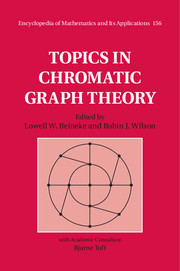Book contents
- Frontmatter
- Contents
- Foreword
- Preface
- Preliminaries
- 1 Colouring graphs on surfaces
- 2 Brooks's theorem
- 3 Chromatic polynomials
- 4 Hadwiger's conjecture
- 5 Edge-colourings
- 6 List-colourings
- 7 Perfect graphs
- 8 Geometric graphs
- 9 Integer flows and orientations
- 10 Colouring random graphs
- 11 Hypergraph colouring
- 12 Chromatic scheduling
- 13 Graph colouring algorithms
- 14 Colouring games
- 15 Unsolved graph colouring problems
- Notes on contributors
- Index
Foreword
Published online by Cambridge University Press: 05 May 2015
- Frontmatter
- Contents
- Foreword
- Preface
- Preliminaries
- 1 Colouring graphs on surfaces
- 2 Brooks's theorem
- 3 Chromatic polynomials
- 4 Hadwiger's conjecture
- 5 Edge-colourings
- 6 List-colourings
- 7 Perfect graphs
- 8 Geometric graphs
- 9 Integer flows and orientations
- 10 Colouring random graphs
- 11 Hypergraph colouring
- 12 Chromatic scheduling
- 13 Graph colouring algorithms
- 14 Colouring games
- 15 Unsolved graph colouring problems
- Notes on contributors
- Index
Summary
The four colour problem is
the tip of the iceberg,
the thin end of the wedge
and the first cuckoo of spring.
W. T. Tutte, 1978A fundamental process in mathematics is that of partitioning a set of objects into classes according to certain rules. Chromatic graph theory deals with a situation where the rules are almost as simple as one can imagine: for each pair of objects we are told whether they may be put in the same class or not. However, the simplicity of the rules does not mean that the problems encountered are simple – on the contrary. Starting from the four-colour problem around 1850, the theory has developed into a many-sided body of problems, theories, results and applications, and even though many problems have been solved, sometimes in surprising ways, the number of simply stated but challenging problems remains large and growing. This explains the popularity of the area and why it attracts so many active researchers.
This book presents a picture of this many-sided body as it has evolved so far. Experts from various parts of the area present main ideas, methods and results, and describe what is important. Map-colouring dominated the field for many years, but with authors like K. Wagner, H. Hadwiger, R. L. Brooks, W. T. Tutte, G. A. Dirac, G. Hajós, T. Gallai and P. Erdős, among others, the theory became more general, abstract and applicable.
The chapters cover much ground. The first one outlines the general theory of colouring graphs on surfaces. Other types of graphs, such as perfect graphs, geometric graphs, random graphs and hypergraphs are then treated in chapters of their own, as are special types of colourings, such as edge-colourings, list-colourings and integer flows. Classical topics, such as Brooks's theorem, Hadwiger's conjecture and chromatic polynomials, are described and updated to current knowledge. Applications and relations to other fields, such as scheduling, games and algorithms, are also included.
- Type
- Chapter
- Information
- Topics in Chromatic Graph Theory , pp. xiii - xivPublisher: Cambridge University PressPrint publication year: 2015

